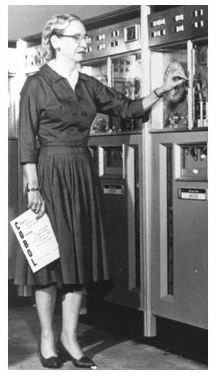This Day in Computer History: December 9
This Day in Computer History
1906
Future computer pioneer Grace Hopper was born in New York City. Not only was Hopper one of the first women in the computer industry, she would make significant contributions to the development of the Harvard Mark II and would develop the first compiler, A-0.
1916
Future cryptologist Irving John Jack Good is born in London, England. He would work on both the Enigma and Teleprinter encrypting machines at Bletchley Park.
1960
Sperry Rand introduced the Univac 1107, the first computer to employ thin-film memory. The magnetic memory technology was an iron-nickel alloy applied in a layer four-millionths of an inch thick on a series of glass plates to provide the Univac with its 128-word general register stack.
1968
At the San Francisco convention center, Douglas C. Engelbart of the Stanford Research Institute demonstrated the NLS (”oNLine System”) to a thousand members of the American Federation of Information Processing Society via the first video teleconference in history. The ninety minute public demonstration introduced the world to a staggering number of ground-breaking technologies, including the computer mouse, dynamic web linking and hypertext, e-mail, graphical user interfaces for operating systems, object addressing, and the video teleconferencing technology underlying the entire presentation, as well as what would later be dubbed the the “paper paradigm,” under which computer interfaces would be referred to by a series of metaphors likening the technology to a real-world office.
1987
The first self-replicating program to cause widespread real-world damage, the Christmas Virus, hit BITNET, causing mail servers across the nation to crash under the strain of excess network traffic.
Microsoft released version 2.01 of its Windows operating system. The new version introduced overlapping windows and the ability to use the protected mode of Intel’s 80286 processor. Price: $100.
1991
The High Performance Computing and Communication Act of 1991 was enacted. The act, which was sponsored by Senator Al Gore, would pave the way for widespread internet access in the U.S. by, among other things, creating a high-speed fiber optic network and funding the National Center for Supercomputing Applications, where the Mosaic Web browser would be developed. In the Fall of 1990, there were 313,000 computers online in the U.S. By the end of 1996, over 10 million users would be online, largely due to the bill.
1996
Microsoft released version 3.0 of its Internet Explorer web browser for Windows 3.1, the first version of the browser to developed independent of any Spyglass source code. It included several major technological advances, including Cascading Styles Sheets support, which was a first for any web browser. It also included support for the Platform for Internet Content Selection (PICS) system, Java applets, and ActiveX controls. The new features would make version 3.0 the first version of Internet Explorer to be widely distributed, and with the release, it would offer the first market competition to the market-dominating Netscape Navigator.
Version 1.3 of the Unicos/mk operating system was released.
1997
Microsoft released BackOffice Server 4.0, which included: Exchange Server 5.5, FrontPage 98, IIS 4.0, Index Server 2.0, Proxy Server 2.0, SMS 1.2, SNA Server 4.0, SQL Server 6.5, Transaction Server 2.0, Visual InterDev 1.0, and Windows NT Server 4.0.
2000
The first digital cinema in the world opens in Hiroshima, Japan. It featured six screens, all digital projectors, and a system of film projectors as emergency back-ups.
2002
Jon Lech Johansen, known by the internet handle “DVD Jon,” plead not guilty to charges of hacking brought by the Norwegian Økokrim, an organization devoted to prosecuting economic crimes, following a complaint filed by the Motion Picture Association (MPA) regarding Johansen’s DeCSS DVD-decryption application.
2005
Yahoo! acquired the Del.icio.us social bookmarking service.
2006
Mozilla released version 3.0 of its Firefox web browser. Code-name: Gran Paradiso.
This post is part of the series: A Chronology of Computer History for the Month of December: This Day in Computer History
This series provides a daily account of what happened on this day in the history of computing and technology. It discusses developments, breaking news, new releases and global implications that occurred as a result of these ground breaking events.
- This Day in Computer History: December 2
- This Day in Computer History: December 3
- This Day in Computer History: December 4
- This Day in Computer History: December 5
- This Day in Computer History: December 6
- This Day in Computer History: December 7
- This Day in Computer History: December 8
- This Day in Computer History: December 9
- This Day in Computer History: December 10
- This Day in Computer History: December 11
- This Day in Computer History: December 12
- This Day in Computer History: December 14
- This Day in Computer History: December 15
- This Day in Computer History: December 16
- This Day in Computer History: December 17
- This Day in Computer History: December 20
- This Day in Computer History: December 21
- This Day in Computer History: December 23
- This Day in Computer History: December 24
- This Day in Computer History: December 25
- This Day in Computer History: December 26
- This Day in Computer History: December 27
